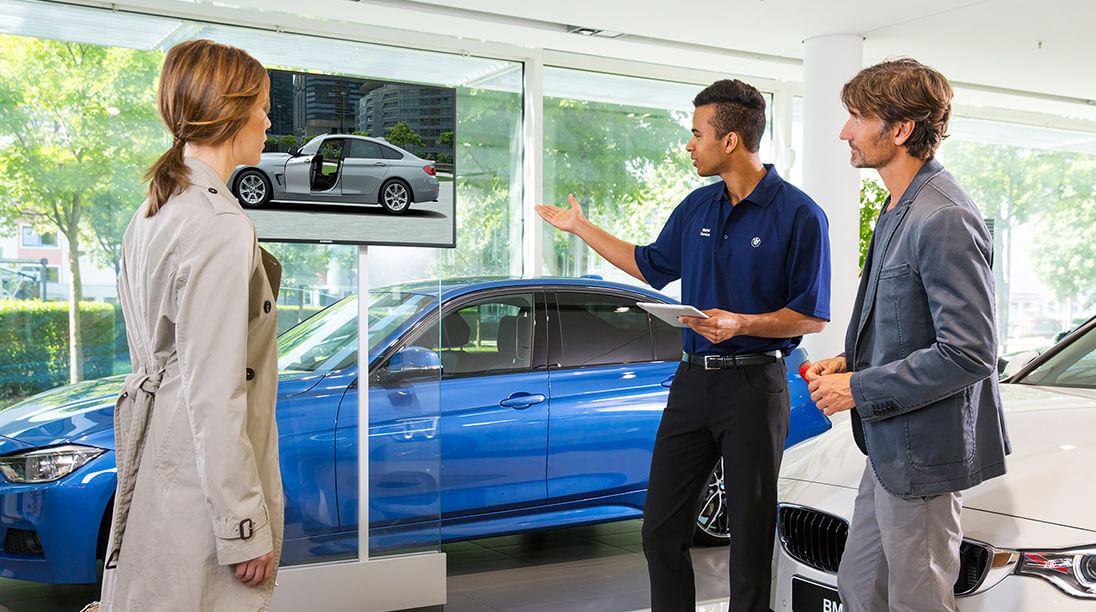Some of the brands are at the forefront of changing their dealer networks to suit the current and future customer.
BMW has identified the need to improve their customer experience by introducing the BMW Genius.
You will now find a product expert who will assist the customer in finding the perfect vehicle to suit their lifestyle and needs. The BMW Genius is specially trained to demonstrate and help the customer become familiar with all aspects of the BMW – before, during and after the purchase.
The BMW product genius is a non-commissioned expert who will spend as long as it takes to educate car shoppers about their choices. The product genius is not encumbered by the sale process and is not motivated to sell a car – their motivation is customer satisfaction. The sales consultant can spend more time on what they do best – facilitating trade-ins, financing and completing the transaction.
This is not a unique concept. It is clearly similar to the Apple Genius program where understanding customers, their needs and making them happy is essential to promoting customer satisfaction which leads to customer loyalty and ultimately future sales.

Toyota has adopted two tier approach – Toyota for Life and Guest for Life.
Toyota for Life concentrates on improving dealership culture, dealer operations and other elements of the customer experience. Basically ensuring the dealership is operating in a relationship-centric fashion .
Toyota Guest for Life focuses on customer loyalty, retention and referral. This is achieved by optimising the accuracy of the dealer database. Traditionally databases have a mixture of active, inactive and unknown customers. The objective is to move the inactive to the active sector. This can be achieved by implementing a number of touch/contact points. By having a structured contact, this increases the ability to create future opportunities in both sales and service. It also cleanses the database on a daily basis.
To work, complete collaboration between all departments is essential. Toyota’s stated aim is to secure 50 per cent of new car sales from customer loyalty and referral programs. As we know the cost of a repeat/referral customer is one tenth of a conquested customer. So this will have the impact of halving the cost of acquisition across the network and improving gross at the dealership level.
Audi is one of the few car companies that has opened digital showrooms in London and Beijing. The London Audi City showroom in Green Park, for example, is the smallest Audi dealership in the UK. It measures only 420 square meters of display space and features around four vehicle models.

Visitors are greeted by customer relationship managers who consult on the brand and advise how to digitally create a car from several hundred million potential configurations. This allows customers to see their vehicle come to life.
This revolutionary approach has led to a 60 to 70 per cent increase in new car sales, with 75 per cent of orders placed by first time Audi buyers.
Although physically displaying only three to four cars (versus 15 to 50 cars in a conventional dealership) these future dealerships will have a virtually unlimited retail space aided by digital tools such as interactive full-sized powerwall configurators.
The digital flagship store will not only be a platform to experience or buy vehicles during your ‘lunch break,’ but also to sell vehicles and to drive leads into conventional dealerships. The dealership network as we know it now will change dramatically within the next few years.
The elephant is definitely in the room.
Take-out message: Brands that fail to improve the overall customer experience run the very real risk of losing the loyalty of their customers.

Audi City
SO WHAT HAS CHANGED AND WHAT IS THE BENEFIT?
| Process Change | Benefit |
| Introduction of product specialist – BMW Genius |
|
|
|
|
|
Customers either ‘buy a product or buy a relationship’A “product-centric” business promotes features and price – whereas a “relationship-centric” business promotes a total solution.
| Product Centric | Relationship Centric |
| Promotes features and price | Promotes a total solution |
| Exploits the value in a transaction | Profits from the value in a relationship (lifetime value) |
| Grows primarily by expanding its share of market | Grows primarily by expanding its share of customer wallet (more services for each customer) |
| Product push approach; little or no customer satisfaction | Tailored product offering based on real customer segments; real–time customer support, personalised interactions; based on behaviours and
buying preferences |
| No ownership of the customer within the organisation; inconsistent behaviours; customer–facing employees lack of authority to resolve customer issues at point of contact | Customer–centric culture pervasive at all levels of the organisation
Employees take clear ownership for customer problems and manage issues through to resolution |
| Technology strategy not aligned with customer-centric culture | Unified vision for data management,
ongoing data quality improvements |
| Broad, undifferentiated offering, not specific to any distinct customer segments | Clearly defined target segments based on understanding of current and potential customer lifetime value |
| No attempt to manage customer lifetime value beyond standard service model | Explicit understanding of customer lifetime value with value–adding interventions at key stages including lapse of warranty, maturity of finance etc., tailored to the needs of all customer segments |
Going from a product-centric to a customer-centric company can give your business a competitive advantage. Doing so will enable your company to retain customers and sustain higher-margin performance. Perhaps the most visible innovation Apple made was through its retail store division. Apple put the customer at the center of its products and services and created incredible brand loyalty.
Rather than establishing a relationship with people after they make their purchase (as is normally the case) you should establish a relationship in advance.
How do we do it?
- Think like a customer
- Customise your value propositions
- The key ingredient in any relationship is communication
- Manage trust throughout the customer life cycle
- Invest in a single customer view and put a currency on your database
- Demonstrate to your team what great customer service can achieve
- Empower your team to deliver great customer service
- Encourage active listening between customers and other team members
- Concentrate on the small stuff
KPMG workshop: retailing into the future part 1
KPMG workshop: retailing into the future part 3
By Brian Fellowes













 Read More: Related articles
Read More: Related articles

